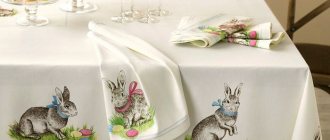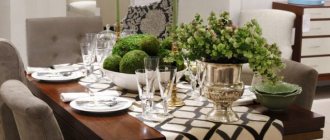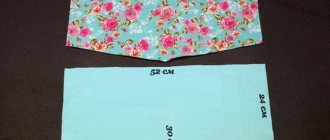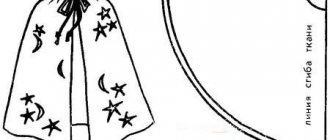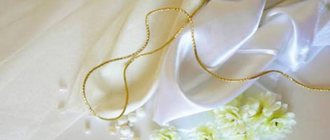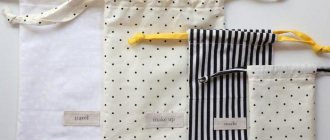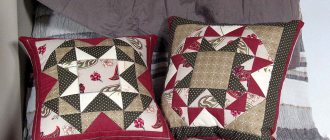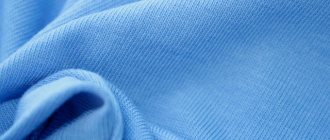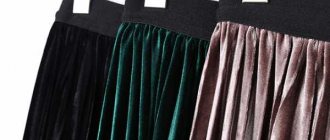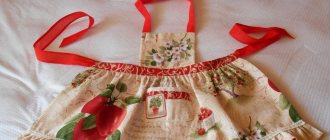Choosing fabric for a tablecloth
The tablecloth on the dining table should be pleasant, pleasing to the eye and setting you up to enjoy dining. In addition to the aesthetic side, do not forget that the dining table is the place where there will definitely be crumbs, drops of tea and stains from sauces, so the material from which the table covering is made should be quickly wiped off or washed and easily ironed.
A beautiful tablecloth - comfort in the house
When choosing fabric for a tablecloth, you should consider the following parameters:
- Purpose (dining, guest or holiday).
- Form.
- Room interior.
Interior in one style
- Quality of the material.
- Material cost.
For a dining table that will be used daily, linen and cotton in non-marking shades are suitable; these fabrics are traditional and elegant. Silk, satin, textured or smooth look perfect on the festive table; these fabrics are very elegant. It is very convenient to use modern fabrics for sewing:
- Mati, its composition includes 60% cotton and 40% polyester, which makes it wear-resistant and durable. In addition, mati is treated with an oil-repellent substance and greasy stains are removed from it easily and quickly.
Important! This fabric has a fire hazard class 1, it ignites quickly.
- The crane consists of cotton fibers with polyesters. It is treated with agents that repel grease and dirt.
Beauty from a crane
These fabrics are suitable for sewing tablecloths for restaurants and for the home.
Note! When choosing fabric for a tablecloth, you should not buy a smooth and slippery fabric; it will slide off the table and wrinkle under your hands.
There is also a huge selection of Teflon-impregnated textiles - soft, durable, easy to wash, these fabrics have a wide range of colors and textures.
What you need to sew a tablecloth on a rectangular table
The first thing you need to do before starting to sew any product is to choose the appropriate material. Due to the fact that tablecloths, napkins and kitchen towels are in a constant risk zone (stains from food, drinks, dirty hands), increased demands are placed on the fabrics from which they are sewn, such as:
- density;
- crease resistance;
- ease of care;
- color fastness;
- environmental friendliness.
If the fabric combines all of the above qualities, dishes do not slip on it and also drapes well, it can be considered an ideal material for sewing. Most often preference is given to:
- cotton that absorbs moisture well;
- natural linen;
- “crane” produced in Belarus;
- blends of cotton and polyester;
- teflon materials.
A significant role when choosing a fabric is played by its color and the presence of a pattern. The most popular and versatile options for the kitchen are light colors, which look elegant and do not spoil the appetite.
Cool shades of blue, green or blue can slightly reduce your appetite, but at the same time calm your frayed nerves. Warm red, orange and brown tones excite the appetite and fit perfectly into a festive or homely atmosphere. Fabrics with patterns are more suitable for decorating children's birthday parties or outdoor picnics.
Having chosen for yourself a more successful option that combines all the necessary qualities, you need to stock up on other materials and accessories that will definitely come in handy when sewing a tablecloth for a rectangular table:
- threads;
- sewing machine;
- scissors with long blades;
- ruler and measuring tape;
- iron;
- thimble and other sewing accessories;
- items for decoration.
Important! It is not at all necessary to decorate a kitchen tablecloth, however, if table textiles will be used only on holidays and when receiving guests, fringe or a border around the edges will only decorate and complement its appearance.
Required materials and tools
To sew a product with your own hands, you will need a minimum set of materials and tools:
- First of all, this is, of course, fabric, thread and needle.
- Sewing machine for smooth and neat seams.
- Scissors (ideally for fabric).
- Tape measure.
- Ruler.
- Tailor's pins to avoid basting the fabric by hand.
- Pattern if the product will have a round or oval shape.
- Chalk or soap for applying patterns to fabric.
You might be interested in: How to properly sew dresses at home yourself
Only basic tools required
Here, perhaps, is the entire list of necessary tools for sewing a tablecloth at home.
How to measure a table depending on its shape
According to the rules of etiquette, the tablecloth should hang from the table to a certain length, which varies depending on the purpose of the covering:
- For the dining table - 20 cm.
- For a holiday - 30 cm.
- For official receptions and wedding banquets - 40 cm.
- For a buffet table - up to the floor.
To determine how much fabric you will need to sew a tablecloth, you need to measure the tabletop, add the length of the overhang and the hem allowance for the fabric (2.5-4 cm).
Important! To make the edge of the tablecloth heavier, you can leave a 10 cm allowance, 5 cm per hem, or trim the edge with a wide braid.
For a square table, calculating the size of the canvas is very simple. To do this, you only need to measure the length of one side of the table, add the length of the overhang and the allowance.
Square table top
For a rectangular table, you will need to measure two adjacent sides and add additional values. For example: the length of the table is 1.5 m and the width is 80 cm. For a tablecloth on the dining table you will need fabric measuring 1 m 98 cm in length and 1 m 28 cm in width.
To calculate the size of a product for a round table, you need to measure the diameter of the table, add the length of the overhang and allowances.
Note! The greatest difficulty will be in determining the size for an oval table.
In order to accurately repeat the oval of the table, you will have to make a pattern for the tablecloth. To do this, display the exact shape of the tabletop on paper, attach it to the panel and add the length of the overhang and allowance.
Oval table top
We sew a round tablecloth for the table with our own hands
Round tables are now back in fashion. Large and small, high and low, choose the right one for your living room, kitchen or veranda. But it’s not always possible to find a tablecloth for a round table. But you can sew it yourself.
How to sew a round tablecloth
Photo: Shutterstock
The tablecloth for a round table is a circle with a frill sewn to it. Measure the diameter of the table. You also need to know the circumference, which can be calculated by multiplying the diameter by 3.14. But if you have a flexible measuring tape, nothing prevents you from measuring the countertop. In the store you can easily find suitable fabric with a width of 150, 180 and even 210 cm. To calculate the amount of fabric for the central part, add 5-7 cm to the diameter and 2 cm for allowances. To calculate the amount of material needed per ruffle, multiply the circumference by 1.5 or 2, depending on how full the ruffles are. If the material is very wide, divide the result in half. You will also need: - fabric for the inner layer - 1 diameter of the tabletop; - non-woven fabric or dublerin; - braid, roll or lace around the circumference of the tabletop; - paper; - lace; - button; - pencil; - chalk; - sewing accessories.
A tablecloth for a round table can also have a seam. In this case, it is better to choose a plain fabric or with a small pattern.
Draw a pattern for the central part on paper. This is just a circle, the diameter of which is 5-7 cm larger than the diameter of the tabletop itself. If you don’t have a large compass at hand, cut a cord whose length is half the diameter of the future circle. Tie a pencil to one end, attach the other to the sheet with a button. Draw a circle, cut it out and align it to the tabletop. Transfer the pattern to the main and additional fabric. Cut out a round section of the tablecloth, leaving seam allowances. A frill is a long strip, continuous or sewn from several parts. If you bought wide fabric, fold it in half lengthwise and cut it exactly in the middle.
You can also add a frill. In this case, cut out the round part and sew it with an overlocker. Crochet the lace. The pattern can be, for example, based on a fillet mesh
Before sewing the tablecloth, duplicate the central part from the main fabric. Fold the seam allowance inward and press. If necessary, make notches in several places, leaving 0.2 cm to the fold line. Make the same blank from the lining fabric. In this case, it does not matter whether the lining is in contact with the table on the wrong side or on the front side. It is important that the fabric does not slip. Pin or sweep round parts at a distance of 3-4 cm from the edge. Sew the frill along the edge where there is no edge, using a basting stitch, and place it in gathers. Place the edge of the frill between the round parts, place a roll or double-folded braid on top of it, sweep and stitch it all together. All your allowances are between the layers of fabric, so your work is finished. You can sew a tablecloth on an oval table with your own hands in the same sequence.
www.wday.ru
Step-by-step sewing of a tablecloth for a round table
The cover on a round table looks very beautiful, covering the tabletop and hanging in loose waves, it will add romance and elegance to the room in which such a table is located.
Step 1. Calculation of fabric consumption
To calculate the fabric consumption for a round table, you need to measure the diameter of the tabletop and divide the resulting value by 2 to find out the radius. Add the length of the overhang and the length of the allowance to the radius and multiply the sum by 2. For example: (table diameter 2 m/2 + 30 cm overhang + 4 cm allowance) * 2 = size of the required fabric 2 m 68 cm by 2 m 68 cm.
You might be interested in this: How to quickly sew a dress on your own with and without a pattern
Step 2: Cut the fabric
The purchased piece of fabric needs to be cut. To do this, fold the canvas four times horizontally and vertically with the front side inward. To prevent the canvas from spreading, pin it together with pins and measure the following value: radius + overhang + allowance. You need to measure using a measuring tape and chalk. Apply one end of the centimeter to the inner corner, and the other to one of the sides of the resulting square at the required distance and move to the other side, making marks with chalk. Connect the marked marks to form an arc. Carefully cut off the excess along the line and process it with an overlocker so that the edges do not fray.
Cutting fabric
Step 3. Corner treatment
A round tablecloth, of course, has no corners, but if the tablecloth is square or rectangular, then the process of processing the corners must be approached very responsibly so that they turn out perfectly smooth and beautiful.
To process and hem corners you will need an iron and a ruler. First you need to mark the planned distance for the hem, this is done twice. Along the line, first fold and iron the first hem, then the second. You should smooth it carefully so that a clear trace of the line remains. By turning the corner you can see a square. You need to tuck the corner so that this square folds in half diagonally, and cut off the resulting small triangle. Next, you need to fold the first hem back and turn the corner inward, fold the second hem and press it. For reliability, you can secure it with a pin.
Corner processing
Step 4. Sew the hem
How to hem a round tablecloth. You need to measure and mark hem lines along the entire edge, fold and baste or secure with pins. For convenience, the hem can be ironed. Carefully stitch with minimal indentation or hem with an invisible seam by hand.
Step 5. Decoration
An ordinary tablecloth is sewn easily and simply, but if you want to add a touch of comfort, originality and extravagance, the tablecloth can be further decorated.
Do this using the following techniques:
- Playing with color or texture. The product can be made from two types of fabric, and they can be combined as a flight of fancy or the general interior of the room suggests.
- Frill. You can play with the length and volume of the overhang; if you add frills or drapery, you will get an elegant, lush tablecloth.
You might be interested in this: Simple patterns and rules for sewing women's jackets and jackets
Playful tablecloth with ruffles
- Lace. You can use fine lace for edging on fancy tablecloths or thick lace for a country style linen tablecloth, there are many options. Since you can sew lace to a tablecloth in different ways, choose the most suitable one. The lace must either be sewn or crocheted onto the tablecloth with an overlap or below the overhang.
To decorate a tablecloth, you can use satin, beads, finishing ribbons, embroidery and other decorations; even a simple stitch made in a contrasting color can decorate the product.
Linen or synthetic? Fabric for tablecloth
The fabric for the tablecloth is chosen based on its purpose. For making an everyday tablecloth
Practical synthetics are quite suitable for the kitchen. A tablecloth made from it will serve faithfully for many years. It is easy to wash without the threat of losing the original color and fears about possible shrinkage of the man-made creation.
An elegant tablecloth intended for family celebrations and festive feasts is best made from respectable natural fabrics: cotton, silk, high-quality linen. with filigree embroidery and noble natural lace, look elegant and luxurious.
. Such products require careful care in order to extend the life of sophisticated masterpieces as long as possible.
Sewing tablecloths for Christmas, Valentine's Day, Easter and other holidays is associated with a special atmosphere inherent in the upcoming holiday. Both mixed and natural fabrics are quite suitable for creativity. In this case, the main importance is given to decorative elements
future tablecloth. You can go beyond the limits of your imagination and make original tablecloths using:
- embroidered motifs
- applications made of felt and other dense fabrics that do not require processing
- satin ribbons
- sequins, beads or buttons
Making your own napkins
When napkins sewn in the same style lie on the tablecloth, it looks beautiful and rich. You can also make napkins with your own hands from leftover fabric, or by planning the consumption in advance. Moreover, doing this is not difficult, like sewing a tablecloth.
First you need to decide what shape the napkins will be: square, rectangular or round, then outline the size, add seam allowances to it and cut it out. Then repeat the same steps as when sewing a tablecloth: iron the hem, work the corners, stitch the edges. The decor of the napkins can match the decor of the tablecloth, you can reduce it proportionally or come up with a different design.
Two-color product
How to sew a tablecloth with your own hands
Of course, almost any tablecloth can be purchased in a store, but nothing can compare in uniqueness to something created independently. Sewn with your own hands, it will be exactly as intended, and in addition, it will be much cheaper than purchased.
Square table
A square tabletop involves covering exclusively with a square tablecloth, which is not difficult to sew.
To do this you will need the following tools and materials:
- paper and pencil;
- ruler or tape measure;
- scissors;
- chalk;
- iron and ironing board;
- sewing machine (or needle if you plan to sew by hand);
- textile.
First of all, you need to measure the tabletop and calculate the consumption of fabric that will be required for sewing.
Since the table has the shape of a square, this can be done according to the following scheme: the length of one side + the length of the fall (20-25 cm) + hem (10 cm). The remaining sides will be the same size.
It is imperative to take into account the properties of the material - whether it is subject to shrinkage. If this is possible, then you need to add another 10-15 cm to the length of each side.
- Iron the fabric well.
- Using a ruler and chalk, make markings in accordance with the obtained dimensions.
- Cut out the resulting square.
- Fold it inside out and iron the edges (1 cm).
- Form corners. To do this, you need to set aside 7 cm from each corner along each side and draw lines between the resulting points. Bend them and stitch the corners. You need to sew the corners so that they are the same, otherwise the finished product will warp and look sloppy.
- Carefully cut off the excess fabric, stepping back from the seams by 5-7 mm.
- Iron the resulting corners.
- Sew on a sewing machine or hand-stitch with a hidden seam along the wrong side of all four sides of the product.
- Press seams.
Oval table
If the table has an oval shape, you cannot do without a pattern.
- a sheet of paper the size of the tabletop;
- pencil;
- scissors;
- ruler;
- sewing supplies.
You can take any paper - graph paper, unnecessary wallpaper and other similar material (you can glue several newspapers together).
- From a sheet of paper, cut an oval equal to the size of the table (simply placing it on the tabletop).
- Pin the pattern onto the fabric. Add at least 25 cm (fall length) and 1-1.5 cm (hem).
- Cut out carefully.
- Fold the edge twice and stitch.
Round table
A square cloth may well be suitable for a round table, but the geometric correspondence still looks more harmonious.
To sew a round tablecloth you will need:
- measuring tape (centimeter or tape measure);
- pencil;
- scissors;
- sewing machine, needles, threads.
To cut out a circle of the required size, you need to determine the diameter of the tabletop, add to it the desired fall length and another 3 cm (for allowance).
- Iron the fabric.
- Using the measurements obtained, cut out a square.
- Fold the fabric in half twice to form a small square.
- Lay a line diagonally along the folded square piece.
- Mark the radius of the blade along the line (half the diameter).
- Using the resulting mark, draw an arc (it should reach the corners of the square).
- Cut the fabric along an arc and unfold it. The result should be a circle.
- Fold along the edge and stitch. You can use piping or braid to make the product look more interesting.
Some fabrics do not require edge finishing and do not fray. In this case, it is permissible to leave them unprocessed.
You can not only sew a tablecloth for the table with your own hands, but also knit it. Products made with crochet for a round tabletop look especially beautiful.
Original options
Tablecloths made from two plain fabrics of the same color, but in different tones, look contrasting and unusual.
Path to pleasure
The coating, made in the form of a path, looks original.
Openwork sophistication
Openwork tablecloths, crocheted or sewn from pieces of lace, on a bare table or on a fabric base, are delicate and elegant for a romantic dinner or a pompous lunch.
DIY beauty
Sewing a tablecloth with your own hands is very easy. And you can get a lot of pleasure from the process, starting from the choice of fabrics and colors, the choice of which is very large and you can choose a fabric that will suit the interior of the room. The size of the tablecloth made by yourself will be exactly under the dining table and you will not have to tuck it or extend it with another tablecloth. And most importantly, with your own hands you can make a work of art, the likes of which no one else will have.
